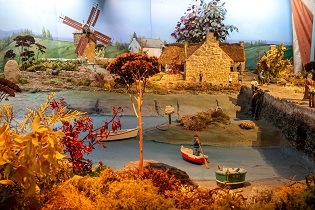
The Tide Mill
The reversed sea current of the Etel river creates a motive power that the four tide mills of Berringue, Demi-ville, Bignac and Pont du Sach used in the past. These were granite buildings whose feet dipped into the "blue" (salty) water. The water was channelled into a "coursier" where 6-metre wheels turned. The millers of yesteryear worked to the rhythm of the tides, both during the day and at night. At low tide, they were milling.
The mill at Bignac has lost its wheel. Those of Berringue and Demi-Ville are hidden at the bottom of the ponds. The Sach mill can be seen at the entrance to Etel.

Habitat
The Breton farmer or sailor has always built his home by drawing his materials from a soil that is 500,000 times older: granite stones, oak wood, slates, thatch. The house has the colour of eternity, but it is distinguished by a sculpted window with festoons, an exterior staircase in cut stone, a doorway with an arch. In some old villages (St-Laurent, Kerlutu, Crubelz, Lésevry) you can still see thatched cottages with their penty (end of the house) and the kardy (karr-dy: cart house) at the bottom of which stood the cider press.

Furniture
It was around the fireplace, the place of Breton life, that sumptuous furniture with well-defined functions was placed side by side and up to the ceiling: cupboards, dressers, bed-closets (sleeping cupboard), chests. Around the table under the only window, six to eight people lived in a promiscuous atmosphere yet individual privacy was preserved. The furniture, waxed to excess, sculpted with chalices, crucifixes, flowers, birds flowers, birds or spindles, were also decorated with rouelles (a Celtic survival). Some of these can be admired at the St-Degan (en Brech) ecomuseum.
Folklore
It is at random on a Sunday, to the strange sound of the bombarde and the biniou played by the Sonneurs (wind sellers) that the simple and good-natured festival (fest) is announced. The young people of Etel still know the age-old dances, learned and rhythmic. The Breton costumes, from a time when appearing was a conscious act of identity, of regional or even local solidarity, have become lighter but the lace headdresses still light up many faded faces. The tradition of the "pardon" followed by the rejoicing, dances, pantagruelian meals, and strength contests, all combine in the same enthusiasm young and old of the country.
Gastronomy
In the Etel region, the excellence of the products, early fruits and vegetables, livestock, salted butter, fish and seafood is combined with tradition (cooking with cider, spices, curry from the "Orient", the port of the Compagnie des Indes) to ensure an "exotic" quality to Morbihan cuisine. Coteriades (fish soups), buckwheat cakes (filled with egg or sausage), crêpes (krampouez) lace, Breton cakes and especially the Kuign Aman (butter cake) are renewed pleasures.